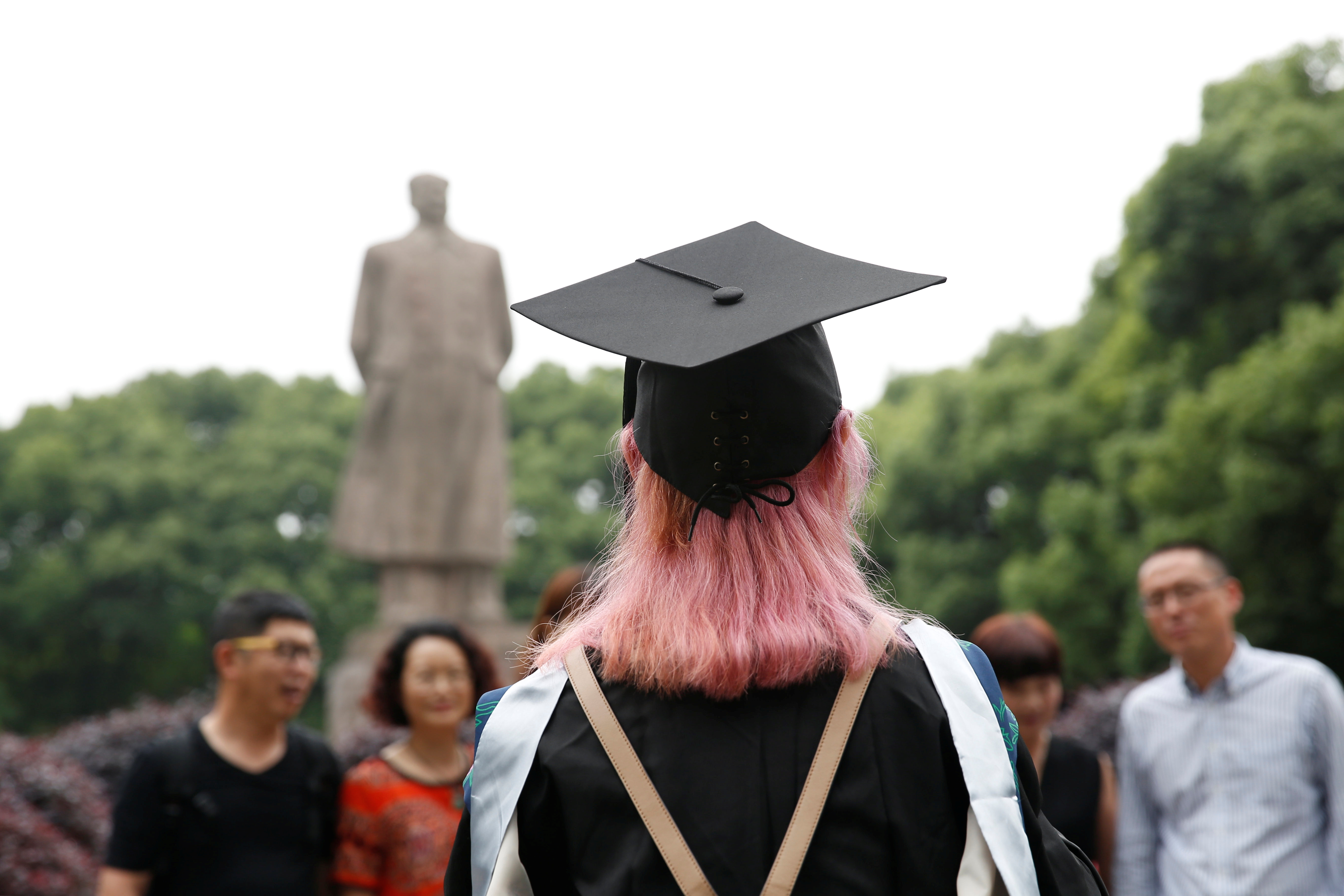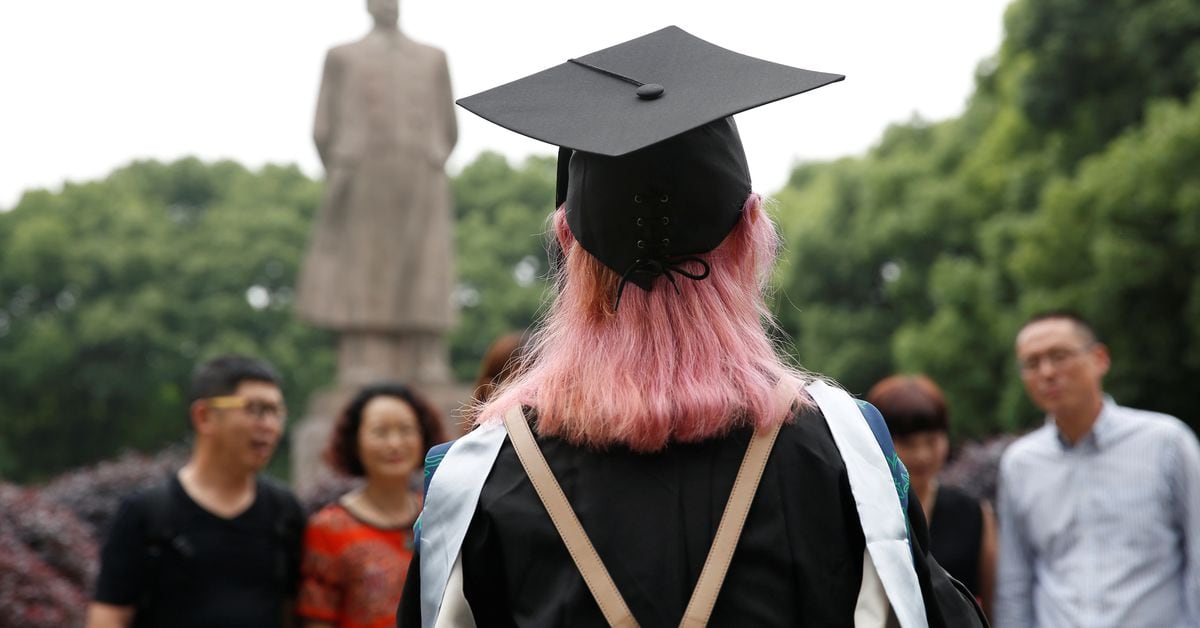This Chinese jobs crisis could be its worst
June 20, 2022
By
Yawen Chen
A student stands in front of the statue of Chinese leader Mao Zedong after her graduation ceremony at Fudan University in Shanghai, China June 23, 2017. REUTERS/Aly Song
HONG KONG, June 20 (Reuters Breakingviews) - The unemployment crisis of 2022 could be the worst since the founding of the People’s Republic in 1949. Nearly one-fifth of those between 16 and 24 years old are not working –
a new record – while surveys suggest national joblessness is approaching levels not seen since global trade crashed in 2008.
China’s survey-based urban jobless data, a series considered more credible than the previous official method, has hovered below 6% throughout the pandemic. Private measurements, however, which are better at counting the country’s 292 million migrant workers, paint a far uglier picture.
In early 2020, Zhongtai Securities economist Li Xunlei's team reported over 70 million jobs had disappeared, before he deleted the report and was removed from his leadership post. Since then, few have issued updated estimates. O
f the 11 million people graduating from college this month, however, only 15% had secured jobs by mid-April, per recruiting services provider Zhaopin.com.
The problem is concentrated in the services sector, which employs roughly half the workforce. Many of them are low-end jobs at restaurants, cinemas and shopping malls.
A survey of 165,000 small and medium companies in March found respondents had enough cash flow to stay afloat for just 2.4 months, the lowest share on record. Poorly timed regulatory crackdowns on technology, education and real estate sectors – many of them major employers – have aggravated the situation.
Advertisement · Scroll to continue
With cities that contribute roughly half of output under some form of lockdown as of April, some economists revised their annual growth projections down to 3%, far below the official target of 5.5%. That would imply 5 million fewer new jobs, pushing the official unemployment rate up nearly one percentage point, according to Cinda Securities analysts.
EMPTY TOOLBOX
In the Mao Zedong era, which ended in the mid-1970s, almost everyone able to work had a job in the command economy: one reason the safety net for the unemployed remains underdeveloped, with
limited coverage and low payouts. Another is that subsequent market reforms allowed officials to treat temporary spikes in joblessness with raw growth.
In the late 1990s, for example, Premier Zhu Rongji prepared China for entry to the World Trade Organization by slashing employment in the public sector. In his first four years,
headcounts at state firms shrank by 30%, and 34 million laid off employees hit the streets. But by freeing up the private sector, Zhu unleashed a period of double-digit export-led expansion that quickly absorbed the surplus workers.
By 2008, when the global financial crisis hit, the productivity gains from opening up to world trade had started to wear off, and the collapse of overseas demand hit manufacturers hard. The unemployment rate reached 9.4%, according to the Chinese Academy of Social Sciences. However, Beijing resolved the issue with monetary and fiscal firepower, slashing interest rates and pouring funds into infrastructure projects.
These methods won’t cut it this time around. China cannot join the WTO twice, and its demographic dividend of young, cheap labour has been exhausted; it now has to worry about underfunded pensions for an aging population. Returns on additional infrastructure investment are naturally lower given how much has already been built. The bad debts that resulted from the 2008 stimulus have yet to be fully digested, constraining monetary easing. Fiscal spending looks exhausted too. The government vastly overestimated incoming revenue for this year’s budget, Nomura analysts noted, leaving a staggering funding gap of 6 trillion yuan ($897 billion).
The export sector that helped keep the economy afloat during the pandemic won’t hold up if partners lurch into recession. It has little need for laid-off English tutors or app developers regardless. The vocational training system could help, but is
in shambles.
The central government will surely pitch in at the margins, but it can’t hire everyone. The military might absorb some college graduates to
its non-commissioned officer class. State-owned enterprises and government-affiliated institutions, which already employ up to 16% of the labor force per World Bank estimates, can add jobs too. Yunnan province announced in June that it will provide an annual subsidy of 50,000 yuan ($7,493) to college graduates who take “grassroot jobs” in education, medicine, farming and poverty alleviation. Suffice it to say these will not produce the disposable incomes companies like Starbucks
(SBUX.O) and Tesla
(TSLA.O) are looking for.
Saddling already bloated SOEs with excess headcount is not fiscally sustainable and deters private business investment. Civil servant jobs are already scarce. In 2021, there were 2 million applicants for only 30,000 positions.
Uncontained, the present crisis risks a vicious cycle in which falling real wages further deter domestic consumption, and therefore investment and job creation. It’s a scenario reminiscent of the stagnation that plagued Japan for decades. That would in turn further burden already strained government finances. At the end lies the Chinese Communist Party’s worst nightmare: social instability among legions of out-of-work people, and not enough jobs to go around.
The services sector that hires over half China's workforce is in deep trouble
S
China’s jobless rate among 16- to 24-year-olds, a group that includes college graduates, climbed to 18.4% in May after hitting a record 18.2% in April, official data showed on June 15. The national survey-based urban unemployment rate reached 5.9% in May.
The unemployment crisis of 2022 could be the worst since the founding of the People’s Republic in 1949. Nearly one-fifth of those between 16 and 24 years old are not working – a new record – while surveys suggest national joblessness is approaching levels not seen since global trade crashed in 2008.

www.reuters.com








